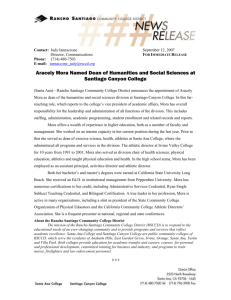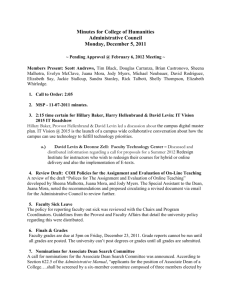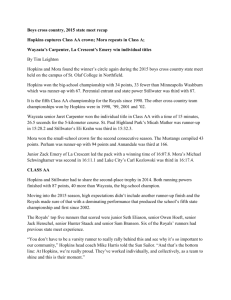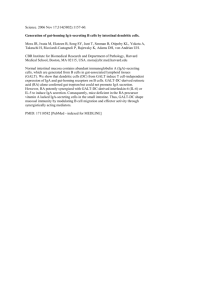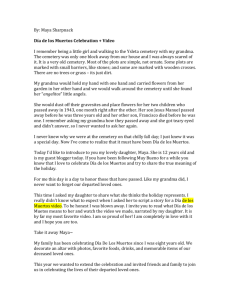The Influence of Pat Mora: How – and Why – Literacy Becomes
advertisement
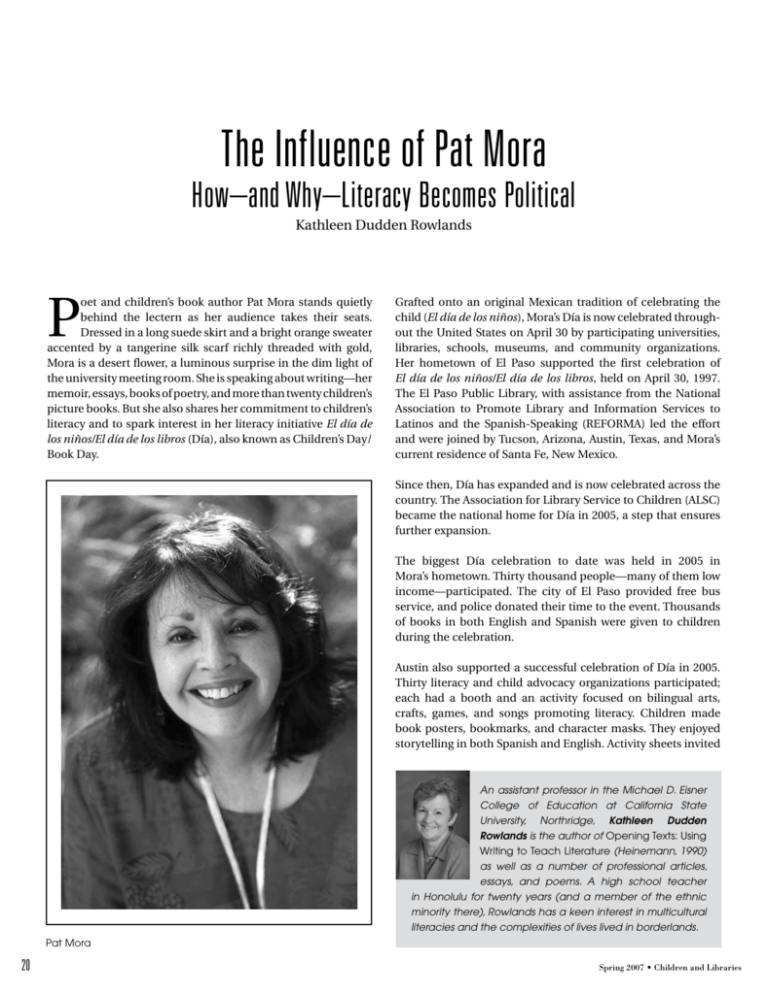
The Influence of Pat Mora How–and Why–Literacy Becomes Political Kathleen Dudden Rowlands P oet and children’s book author Pat Mora stands quietly behind the lectern as her audience takes their seats. Dressed in a long suede skirt and a bright orange sweater accented by a tangerine silk scarf richly threaded with gold, Mora is a desert flower, a luminous surprise in the dim light of the university meeting room. She is speaking about writing—her memoir, essays, books of poetry, and more than twenty children’s picture books. But she also shares her commitment to children’s literacy and to spark interest in her literacy initiative El día de los niños/El día de los libros (Día), also known as Children’s Day/ Book Day. Grafted onto an original Mexican tradition of celebrating the child (El día de los niños), Mora’s Día is now celebrated throughout the United States on April 30 by participating universities, libraries, schools, museums, and community organizations. Her hometown of El Paso supported the first celebration of El día de los niños/El día de los libros, held on April 30, 1997. The El Paso Public Library, with assistance from the National Association to Promote Library and Information Services to Latinos and the Spanish-Speaking (REFORMA) led the effort and were joined by Tucson, Arizona, Austin, Texas, and Mora’s current residence of Santa Fe, New Mexico. Since then, Día has expanded and is now celebrated across the country. The Association for Library Service to Children (ALSC) became the national home for Día in 2005, a step that ensures further expansion. The biggest Día celebration to date was held in 2005 in Mora’s hometown. Thirty thousand people—many of them low income—participated. The city of El Paso provided free bus service, and police donated their time to the event. Thousands of books in both English and Spanish were given to children during the celebration. Austin also supported a successful celebration of Día in 2005. Thirty literacy and child advocacy organizations participated; each had a booth and an activity focused on bilingual arts, crafts, games, and songs promoting literacy. Children made book posters, bookmarks, and character masks. They enjoyed storytelling in both Spanish and English. Activity sheets invited An assistant professor in the Michael D. Eisner College of Education at California State University, Northridge, Kathleen Dudden Rowlands is the author of Opening Texts: Using Writing to Teach Literature (Heinemann, 1990) as well as a number of professional articles, essays, and poems. A high school teacher in Honolulu for twenty years (and a member of the ethnic minority there), Rowlands has a keen interest in multicultural literacies and the complexities of lives lived in borderlands. Pat Mora 20 Spring 2007 • Children and Libraries The Influence of Pat Mora acquire both an understanding of reading and the knowledge base needed for comprehension in a second language. A Native American dance group performs in Tulsa, Oklahoma (Photo courtesy of Keba Ballard). them to write or illustrate stories. The day engaged and enthralled children of all ages and of many cultures with the wonders offered by books. For Mora, community outreach and cooperation are important side benefits of Día. She is pleased that the event offers communities opportunities to promote issues such as health services or Head Start programs to families who might not otherwise have access to that information. However, no matter what else is included, children and the development of bilingual literacies remain the main focus of every Día celebration. From its earliest inception, Día has been a celebration of childhood and bilingual literacy. As a result, its goals have included commitments to: 1. honoring children and childhood; 2. promoting literacy and the importance of linking all children to books, languages, and cultures; 3. honoring home languages and cultures, and thus promoting bilingual and multilingual literacy in this multicultural nation, and global understanding through reading; 4. involving parents as valued members of the literacy team; and Spring 2007 • Children and Libraries 5. promoting library collection development that reflects our plurality. These are not frivolous goals, and Mora’s commitment to Día is about much more than getting a few pretty picture books into the hands of youngsters—even those who have no books available in their homes. Día is a critically important effort on behalf of children from disadvantaged and nonmainstream social and economic backgrounds. First, Día reminds librarians to assess and increase their collections. They must expand the bilingual offerings available to children because Día typically escalates demand. One Oregon library, for example, found that the circulation of bilingual books increased by 300 percent in the month around Día. Efforts such as these are central to developing literacy among all children. The importance of bilingual literacy is, of course, well established. Children who read in their primary language In addition, an event such as Día may offer one of the few opportunities bilingual children—particularly those from high poverty areas—have to experience books that reflect them and their cultures. Much research has established that children from poor communities have less access to books at home, at school, and from public libraries than children from more privileged backgrounds. Simple lack of access inhibits literacy development, because, as noted literacy scholar Stephen Krashen has argued many times, children with access to reading materials read more than those without access, and children who read more, read better. Access to books—such as that provided by events like Día—may be the single most effective weapon in the battle for literacy among the economically disadvantaged. Promoting Día’s important goals annually isn’t enough, of course. Support of bilingual literacy means parents, teachers, and librarians remembering that every day should be thought of as El día de los niños/ El día de los libros. It means promoting what Mora calls “bookjoy” routinely, by finding habitual ways to link children to books, languages, and cultures. Día Award Winners These libraries have been honored with the REFORMA Estela and Raúl Mora Award for their Día celebrations. Visit www.patmora.com for more information. 2000 Austin (Tex.) Public Library 2001 El Paso (Tex.) Public Library 2002 Multnomah County (Ore.) Library 2003 Corvallis-Benton County (Ore.) Public Library 2004 Providence (R.I.) Public Library 2005 REFORMA de Utah 2006 Kenton County (Ky.) Public Library 21 The Influence of Pat Mora for her voice—and others like hers—to be heard. In her essay “Endangered Species” she writes, “Like many Chicana writers . . . I felt our voices were absent from what is labeled American literature but is U.S. Eurocentric literature seasoned sparingly with a bit of Color [sic].”3 For Pat, writing was fundamentally about preserving culture while making it accessible—and understandable—to others. Dancers at Multnomah County (Ore.) Library. That a successful and prolific author of many bilingual children’s books would be a strong advocate of bilingual literacy efforts makes sense. But Mora’s passion to expand children’s literacy arises from a well far deeper than a mercenary desire to encourage potential readers. Of Mexican heritage, she grew up in a bilingual household in the border town of El Paso. Books were central to her childhood. On her Web site she writes, “When the desert wind howled outside, I felt safe in my bed with a book.”1 Her mother was a prolific reader who actively supported her children in their literacy development by reading to them and encouraging frequent sojourns to the library. In addition, Mora’s aunt taught the children the power of story, enthralling them at a young age with tales in English and Spanish about growing up in Mexico. For Mora, literacy—bilingual literacy— was a powerful foundation of her home culture. Mora began writing in elementary school, although she claims she didn’t really become a writer until she was in her late thirties. “As a child, I never thought of myself as a writer because I never saw a writer who looked like me,” she explains. “I never knew a writer who was bilingual.”2 22 In 1979, she finally began taking writing seriously. Still, because she was a university administrator and the mother of three teenagers, she couldn’t write Mora’s commitment to Día is about much more than getting a few pretty picture books into the hands of youngsters— even those who have no books available in their homes. Día is a critically important effort on behalf of children from disadvantaged and nonmainstream social and economic backgrounds. full time. “I was really only doing the writing from the edges,” she admits. In spite of the difficulties finding time to write, Mora felt it especially important Success came slowly. Mora sent in several manuscripts and received rapid rejections, frustrating her. “Writing for publication was discouraging,” she explains, “and rejection was hard to deal with.” Finally she had luck publishing adult poetry. And at last Knopf bought the manuscript for her first picture book— Tomás and the Library Lady. However, three illustrators worked with it before the book was finally published ten years later. As a result, in 1992, A Birthday Basket for Tía became Pat’s first published picture book. Tomás was not published until 1997. Mora credits a 1994 poetry fellowship from the National Endowment for the Arts with pushing her to become a fulltime writer. She explains, “After teaching all levels, working in university administration, briefly directing a natural history museum, and serving as a consultant on U.S.-Mexico exchanges, I now devote myself to a life of words.” Throughout her life, Mora has inhabited what Mary Louise Pratt has called a “contact zone,” a space “where cultures meet, clash, and grapple with each other.”4 Her first collection of essays, published in 1993, is titled Nepantla—a Nahuatl Indian word meaning “the land in the middle.” In it she writes, “I am a child of the border, that land corridor bordered by the two countries that have most influenced my perception of reality.”5 For Mora, the border is not a dividing line between two adjacent nations, but a physical and cultural space shaped by the ebb and flow of language and wisdom from each. Border living is living with dissonance. She writes, “There probably isn’t a week of my life that I don’t have at least one experience when I feel that discomfort, Spring 2007 • Children and Libraries The Influence of Pat Mora the slight frown from someone that wordlessly asks, ‘What is someone like her doing here?’”6 As might be expected, cultural dissonance is a theme throughout Mora’s work. Her much-anthologized poem, “Sonrisas” (“Smiles”), begins “I live in a doorway/between two rooms. . . . ”7 Caught between the Anglo world of teacher and university administrator, and of Chicana culture, the speaker observes both worlds, but is unable to participate fully in either. As Mora writes in “Two Worlds,” another, even more explicitly autobiographical poem from My Own True Name, she is “Bi-lingual, Bi-cultural,” and she is “American but hyphenated.” To Anglos, she is “perhaps exotic/perhaps inferior, definitely different.” To Mexicans, she is alien even though she speaks Spanish. To both cultures, she is “a handy token/ sliding back and forth/between the fringes of both worlds.”8 Border people with hyphenated cultures assimilate into the cultures they inhabit more rapidly, perhaps, than those cultures are able to assimilate border people. Other poems recount the continuing humiliation of encountering Anglo prejudices—whether the speaker is a new arrival to the United States (as in the poem “1910,”) or a native-born citizen of the United States.9 In “Sugar,” for example, a family stops at the local store on its way home from the fields to enjoy a payday treat of candy, ice cream, or soda. The speaker, a teenage girl born in the United States watches the Anglo customers “shrink from our brown skin” and agonizes, “Why do we come here?” She overhears a woman call her family “dirty wetbacks,” wondering aloud if “they ever/bathe.” The poem ends with the girl’s physical (and futile) attempt to wash away her pain, ironically becoming—literally—a “wetback” in the process: I scrub her words away in the shower, scrub My skin till it burns, let the water run Down my back and my dark American legs. Spring 2007 • Children and Libraries Clowns spread the joy at Glendale (Ariz.) Public Library. The girl is powerless in the face of humiliation. A shower cannot wash away her pain. Without adequate recourse, the experience is devastating.10 Oppression, survival, and often triumph commingle in Mora’s work. She recognizes the power provided by her heritage culture as she and others like her join the mainstream. In “University Avenue” she writes, “We are the first/of our people to walk this path.” Although the students “move cautiously,” they become “guides for those who follow.” They have been prepared by their people for success, given “gifts from the land.” They “do not travel alone” because their “people burn deep within.”11 As for these students, heritage gifts empower Mora’s work, both as a writer and as a social activist. When Mora speaks, her voice is a desert breeze, warm and powerful. “I have issues I feel passionately about,” she says. My essays and public speaking allow me to be part of the kinds of societal change I want to see take place. A key issue is having the U.S. Latino and Latina voice heard and respected, whether we are talking about public policy, literacy, or American literature for children or adults. I have a desire to move away from the margin. I want us to be perceived as active participants in creating a society we all want to live in. Yet I have learned that committing yourself to those who are often denigrated, ignored, and seen as inferior can be heartbreaking work. It is heartbreaking, indeed, to face denigration, particularly when it arrives unexpectedly. Mora tells the painful story of a press known for publishing work for Latinos. The editor received a letter from a teacher in western Pennsylvania saying, “There is no need to send me your catalog. I teach gifted and talented; I am not the resource teacher.” Because that teacher had no Spanish-speaking children in her classes, she simply felt it unnecessary to expose her students to Latino cultures. Equally unsettling is the teacher’s assumption that only students in the resource classes would understand (or need) bilingual or bicultural texts. Because we are products of our personal experiences, Mora believes all teachers can find places to connect with difference if only they know how to look. She tells of another teacher, also from western Pennsylvania, who became interested in her writing and her work with Día. “The woman created an incredible experience for me when I was there,” Mora says. 23 The Influence of Pat Mora The students were beautifully prepared, and she had a little song I had written for Día put to music so it could be performed. At the end of the visit I asked her,”Where did your passion for Latino children—any children who are not perceived as mainstream—come from?” She looked at me and answered, “I was raised Mennonite. I know what it’s like to be perceived as different.” Mora wants publishers to commit to producing work produced by Latinos and Latinas. Experience has taught her that “publication [of Latino texts] is a really tough journey. There are some books that can take ten years to reach the bookstores.” She explains, “There is a lot of resistance to Latino and Latina writers. Editors won’t admit it. They believe they are open, but when you look at their catalogs, you can tell.” All aspects of the industry have to change in order to make a real difference. I want to see young Latinos thinking about going to New York and becoming editors or marketing directors. If we really want things to be different, we need to see diversity all the way through. When new A Look at How Libraries Celebrate Here’s a look at what some libraries have done to celebrate Día. My branch library celebrated Día with three storytimes. We read stories in Spanish (Sueños by Margarita Robleda or Pinta Ratones by Ellen Stoll Walsh) and Spanish-theme stories in English (La Cucaracha Martina by Daniel Moreton or Gotta Go! Gotta Go! by Sam Swope). We counted to ten in English and Spanish and sang “De Colores” by Raffi. Each program ended with a craft. Our branch doesn’t usually have Spanish storytimes, so parents welcomed the change.—Anne Robert, Jacksonville (Fla.) Public Library Providence (R.I.) Public Library won the 2004 Mora Award. Each year, the library sponsors an annual bilingual (English/ Spanish) story writing competition. This contest, which has grown in popularity over the last four years, promotes the celebration of culture and bilingual literacy. In 2005, in addition to Pablo Alvarez’s book-making workshop, we held classes in creative writing, family writing, and drawing. Eighty-seven children, ages two through twelve, from sixteen different schools and child care centers submitted books to the contest. Ten outstanding books were selected. All books were displayed at the R.I. School of Design Museum during the fifth annual El día de los niños/El día de los libros celebration, which featured award-winning author/illustrator Yuyi Morales. More than seven hundred participated.—Tonia Mason, Marketing and Communications Director, Providence (R.I.) Public Library We held our first El día de los niños/ El día de los libros event in 2004 on a Friday evening with a Spanish DJ playing Spanish pop hits, clowns leading games, and a live Spanish band. In between performances, children’s librarians read Spanish stories and lead finger plays in Spanish. Craft programs offered children the opportunity 24 editors or assistant editors get hired, they often look just like the last ones. And they come from similar experiences. We need diversity in reviewers as well if we are going to broaden the kinds of books readily available. Getting diverse books into bookstores—especially the megabookstores—is another difficulty. We all need to be more aggressive in going to talk to the bookstores about what we want. We need to go to the manager and say, ‘Where are the children’s books by Latinos?’ And we need to be prepared if they say, ‘Do you have a list of what you are looking for?’ We need to be ready to to make papel picado and cookie sombreros. The following year, we had a Spanish DJ who played Spanish pop songs and led games and karaoke. Crafts and storytimes rounded out the event. In 2006, we had a local musician perform songs from Latin America. Families were invited to come early and make maracas to use during the program. The musical tour through Latin America involved lots of singing, dancing, and maraca playing. Both the 2004 and 2005 events were supported by Library Services and Technology Act (LSTA) grant funds; we did not have extra funding in 2006 for our program.—Katie Guzek, Brown County Library, Green Bay, Wisc. In 2006, we featured South American music and dancers. We decorated the library with paper flowers and piñatas and offered arts and crafts projects, including making necklaces, fuzzy caterpillars, and foldable books. The event drew about eight hundred kids to the branch, and we had about thirty volunteers.—Stephen Ellis, Gresham (Ore.) Library In 2006, nearly two thousand children and adults enjoyed a week of bilingual literacy activities related to El día de los niños/El día de los libros (Children’s Day/Book Day) sponsored by four public libraries and eight other literacy agencies in the area. A literacy fiesta including bilingual storytimes, crafts, music, dancing, piñatas, cascarones, and free books for all children topped off the week. Día activities were supported by a grant from the Institute of Museum and Library Services under the provisions of LSTA as administered by the Kentucky Department for Libraries and Archives under the direction of the Kenton County Public Library. For their efforts, the libraries won the 2006 Estela and Raúl Mora Award.—Sara P. Howrey, El Día Committee of Northern Kentucky and Cincinnati, Boone County (Ky.) Public Library, Campbell County (Ky.) Public Library, Kenton County (Ky.) Public Library, Public Library of Cincinnati and Hamilton County (Ohio) Spring 2007 • Children and Libraries The Influence of Pat Mora help, not just complain. We need to be ready to help create change. Mora’s activism is not limited to literacy or causes affecting diverse peoples living in the United States. She is also a committed feminist. Many people believe that the phrase . . . “intelligent Mexican woman” is an oxymoron. We live in a patriarchal world that changes very slowly. There were years where the word feminist has been contested because women from African American, or Chicano, or Native American traditions and cultures felt that it wasn’t their word because white feminists had not included all of us. I am committed to the word because I feel that for those of us who believe in the power of the word, part of our work in the world is to expand definitions of words to what they could be or should be, to develop their full wealth. Were I not as committed as I am to women’s full development, I might not have chosen to do as many picture books that have spunky girls at their core. Her picture book Doña Flor illustrates her commitment to portraying strong Mexican women. “Children grow up with the image of Paul Bunyan and his strength. I wanted them to see Doña Flor, this amazing woman who is bigger than a mountain and bilingual. I wanted them to see how incredibly powerful she is,” she said. “As you read the book, you learn that she speaks every language—even rattler! She is close to all the animals, and they are very much a part of her life because she understands their languages.” Because authors of children’s books rarely have any influence over the illustrator a publisher will select for their words, Mora was anxious to see how Raúl Colón would portray her heroine. “I wondered, ‘How would he see this woman who is taller than a mountain? How would he capture that?’” She was delighted by Colón’s interpretation. “From the beginning, I was crazy Spring 2007 • Children and Libraries about his images. Doña Flor looked so Mexicana, and I loved that about what Raúl captured. She is beautiful, and she is utterly immense. I mean, I knew she was big . . . I wrote the book! But to show how big she is, the illustrator used just her foot across two pages! And the people next to that foot look like leprechauns!” Mora is skilled with the nuances and the power of language. Her influence is becoming “utterly immense” as well. As Henry Giroux asserts, “literacy becomes an enabling condition” because it affords people opportunities to choose and Author Yuyi Morales reads at Providence (R.I.) Public Library shape their societal (Photo courtesy of Tonia Mason). roles, emancipating themselves from Univ. of New Mexico Pr., 1993), 15. potentially “oppressive and colonizing 4. Mary Louise Pratt, “Arts of the practices.”12 Literacy empowers. And Contact Zone,” Profession 91 (1991): Mora is determined to empower all oth34. ers living in borderlands—physical or 5. Mora, Nepantla, 5–6. cultural—even as language has empow6. Ibid., 6. ered her. 7. Pat Mora, “Sonrisas,” Borders (Houston: Arte Público Pr., 1986), Additional information about El día de 20. los niños/El día de los libros can be 8. Pat Mora, “Two Worlds,” My Own found at www.patmora.com and www True Name: New and Selected .ala.org/dia. Poems for Young Adults 1984–1999. (Houston: Arte Público Pr., 2000), 39. 9. Pat Mora, “1910,” My Own True References and Notes Name, 30. 1. Pat Mora, www.patmora.com 10. Pat Mora, “Sugar,” My Own True (accessed July 5, 2005). Name, 44. 2. Pat Mora, telephone interview with 11. Pat Mora, “University Avenue,” My author, May 12, 2005. All other Own True Name, 23. direct quotes from Mora come from 12. Henry A. Giroux, “Literacy, this interview. Pedagogy, and the Politics of 3. Pat Mora, “Endangered Species,” Difference,” College Literature 19 Nepantla: Essays from the Land in (1992): 1–11. the Middle (Albuquerque, N.M.: 25
